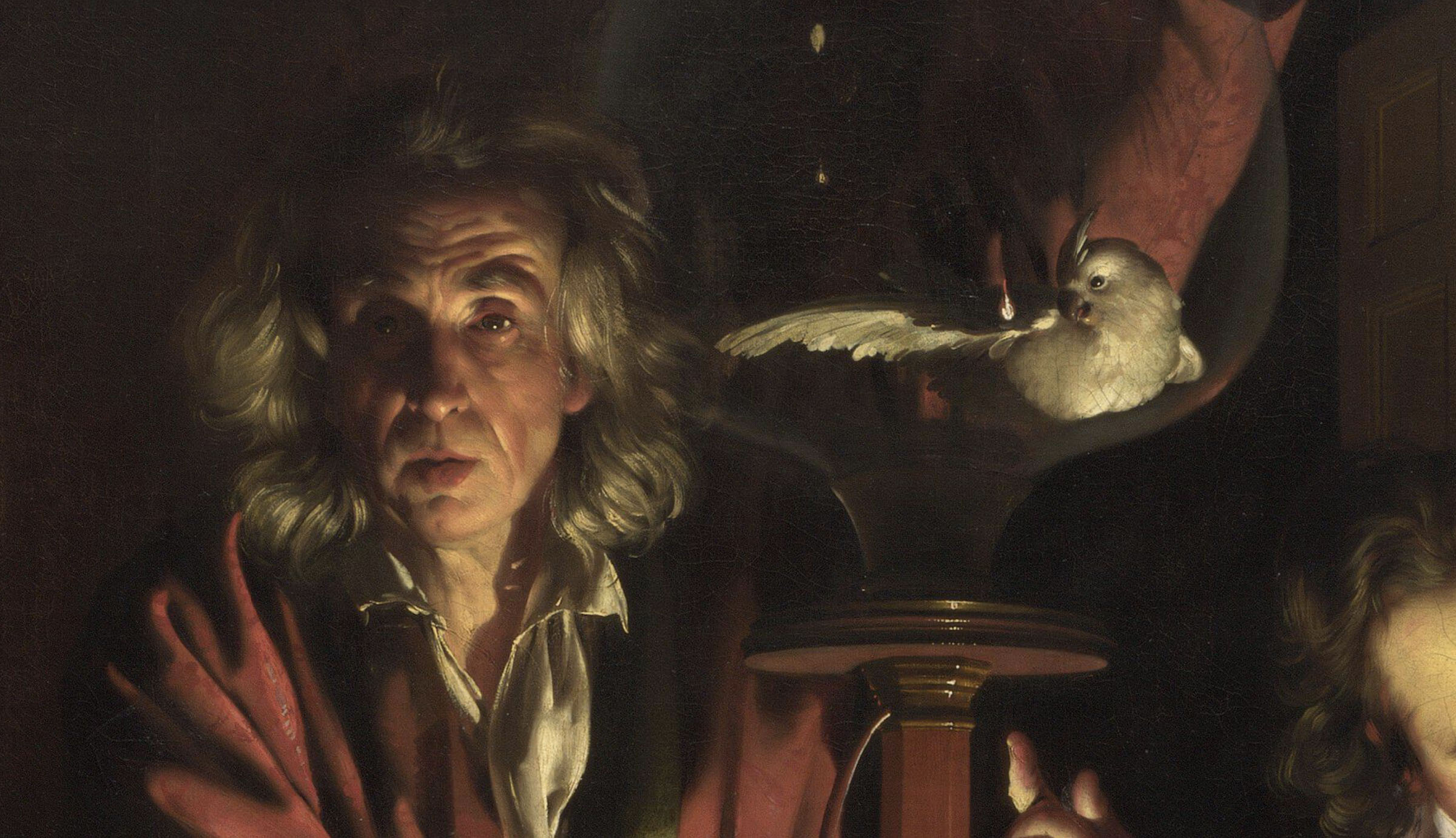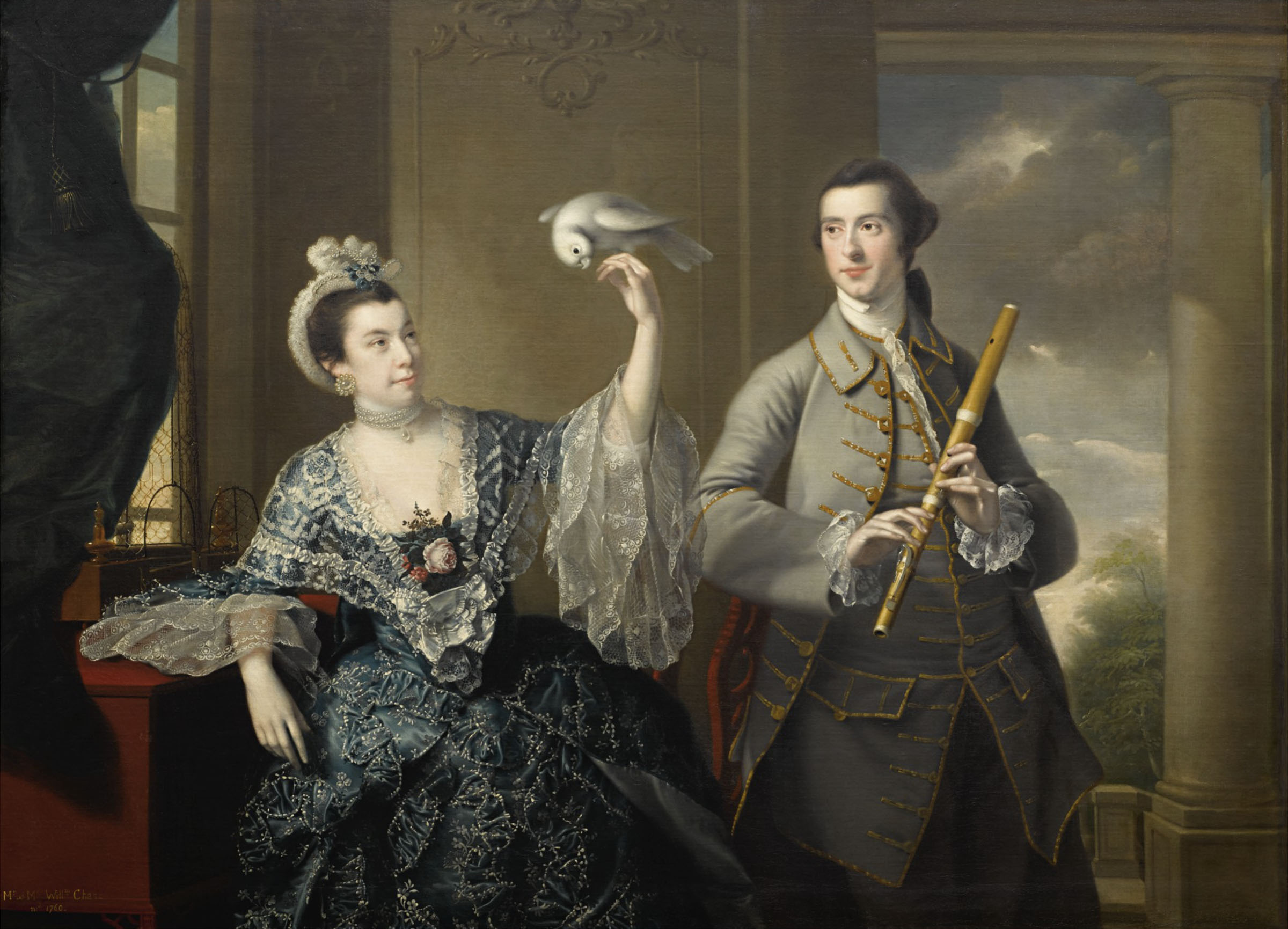Horror of the Vacuum
 |
| Small detail of Joseph Wright of Derby's Experiment on a Bird in the Air Pump, 1768. National Gallery, London |
A fashionable company observes a candlelit experiment. A cockatoo is placed in a glass jar attached to a vacuum pump. As the air is withdrawn, the vacuum mutes its song and renders its wings useless. The bird will suffocate without air, but the experimenter (wild-haired, in a red robe) may spare the bird's life if he acts in time. A seated figure at left holds a watch. The scientific men's dispassion is contrasted with the emotion of the two girls. The older girl can't bear to watch.
 |
| Joseph Wright of Derby, Experiment on a Bird in the Air Pump, 1768. National Gallery, London |
 |
| Illustration of air pump from Robert Boyle's New experiments physico-mechanicall, touching the spring of the air, and its effects, 1662 (second edition) |
The Huntington has built a focus exhibition around the Wright painting's loan. "Science and the Sublime: A Masterpiece by Joseph Wright of Derby" (through May 30, 2022) includes rare books, two Wright paintings, and a 19th-century air pump from the Huntington's collections.
Alchemist and physicist Robert Boyle (1627-1691) originated the bird-in-vacuum experiment. His book New experiments physico-mechanicall, touching the spring of the air, and its effects describes how the properties of air and vacuum may be demonstrated by putting a lighted candle or a bell in the vacuum chamber. As the air is withdrawn, the vacuum snuffs the candle, mutes the bell.
Boyle's Experiment 41 put a live creature in the chamber. He tried flies, snails, eels, mice, and birds. Boyle wrote on an experiment with a lark: "The Bird for a while appear'd lively enough; but upon a greater Exsuction of the Air, she began manifestly to droop and appear sick, and very soon after was taken with as violent and irregular Convulsions, as are wont to be observ'd in Poultry, when their heads are wrung off: For the Bird threw her self over and over two or three times, and dyed with her Breast upward, her Head downwards, and her Neck awry."
A live animal demonstration often became the focus of popular lectures, drawing crowds as well as controversy. It rates mention in Mary Wollstonecraft Shelley's Frankenstein (1818): "My utmost wonder was engaged by some experiments on an air-pump, which I saw employed by a gentleman we were in the habit of visiting," recalls Victor Frankenstein. Shelley's readers are led to infer that air-pump experiments sparked Dr. Frankenstein's interest in reanimation.
So did Wright witness an experiment like the one in the painting? Possibly, but not with a cockatoo.
Wright knew several members of the Lunar Society, Birmingham's gentleman-scientist dinner club that met each month near the full moon. It's known that Scottish astronomer James Ferguson (1710-1776) lectured on and demonstrated an air pump at the Lunar Society in 1762. Wright may have seen that lecture, though his painting, made about 6 years later, is unlikely to be an exact transcription.
For one thing, Ferguson disapproved of using live animals in his demonstration. He rejected the practice as "too shocking to every spectator who has the least degree of humanity." Ferguson substituted an air-filled bladder (a balloon) for the bird or mouse. The bladder expanded or burst as the air pressure decreased. Wright did several candlelight paintings of boys playing with an inflated pig bladder. One is in "Science and the Sublime"; another was acquired by the Getty in 2020.
 |
| Joseph Wright of Derby, sketch for Experiment on a Bird in the Air Pump. Private collection |
 |
| Joseph Wright of Derby, Mr. and Mrs. William Chase, 1760. Private collection |
Cockatoos were rarely seen in England in Wright's time. But Wright had evidently seen one. He featured a cockatoo in a 1760 double portrait, and there's a sketch of just the bird.
In Experiment on a Bird, the cockatoo's prominence invites empathy, as do the girls' reactions, hinting that the cockatoo may be a family pet. Sacrificing an exotic, expensive, (and beloved?) bird makes no sense, but like Shelley's Frankenstein, the painting has the unquestioned conviction of a dream, or nightmare. Despite its artistic liberties, Experiment on a Bird in an Air Pump has become the 21st century's definitive image of Enlightenment science.
The blending of science and show business is still with us. Social media-savvy physics teachers have devised a contemporary version of Experiment 41 using marshmallow Peeps birds or bunnies. Filled with tiny air bubbles, the marshmallow candy is a "balloon" that expands as the air pressure drops, then collapses into a gummy mess.
Comments
Wright's painting shows how a lot of thought and technical skill could be invested in an artwork of the past. Now, in today's era, certain things often gets high marks for being mainly hip and trendy.
But I guess that's always been true to a certain degree. However, in the 2000s, that favors the more esoteric than before?
Not sure if cultural trends in general are a sign of the wheels slowly coming off the car:
https://www.npr.org/2022/02/07/1078870668/new-music-cant-compete-with-old-music-great-resignation-or-the-great-reshuffle
But I hold with astronomer James Ferguson's distaste of using live animals in Enlightenment-era demonstrations as "too shocking to every spectator who has the least degree of humanity."
After a point, it was all just gratuitous barbarism, when non-torturous options were available.
I support animal experimentation to cure human suffering. But to this day you've got cock fights for sport, and animals used in testing face creams.
Ugh. The world we live in!